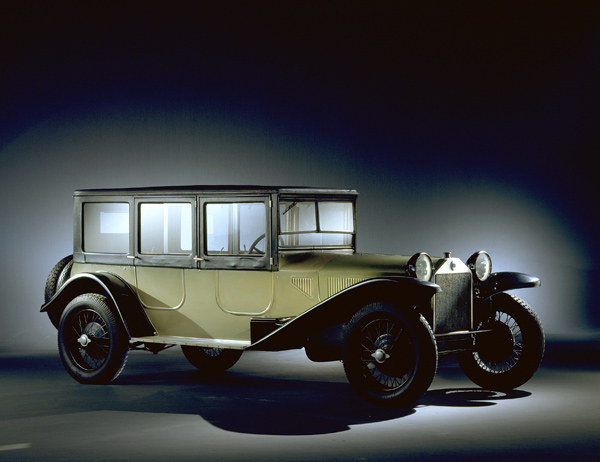|
Lancia Kappa (1919-1922)
The end of the war saw the launch of the Lancia Kappa. The Lancia Kappa is based heavily on the Lancia Theta. It had detachable
cylinder head and Zenith carburettor. Although it had a longer wheelbase than the Lancia Theta, the brakes, steering, suspension
and electrical components were the same. First time for Lancia the gearchange and handbrake levers were mounted centrally
in the car. The Lancia Kappa was successful with around 1,800 Kappas produced.
Lancia Dikappa (1921-1922)
The Lancia Dikappa was the sports version of the Lancia Kappa. It had overhead valves rather than side valves. Its actual
power was 87 hp. It had trhe same chassis as the Lancia Kappa but with aluminium panels on the wooden frame. Totally around
160 units of the Lancia Dikappa was made.
Lancia Lambda
The Lancia Lambda was a very advanced car for its time and was quite a sensation in the automobile way. This car came with
a unitary construction, a world first. Vincenzo Lancia was inspired by the hull of a ship and patented the unitary construction.
Also the propeller shaft from the front to the rear axle was in a tunnel in the floor of the car. A similar transverse tunnel
contained the rear axle. These tunnels added to the rigidity of the car and lowered its centre of gravity. Hence the car had
exceptional handling and ride quality at those times. It also had the first independent suspension in the front. The ride
quality was praised heavily by British magazine, AutoCar, in its road test in 1923. It also had a narrow V engine which ran
up to 3,250 rpm. Unlike previous the Lambda was delivered as completed cars. The chassis was not available for modification
for coachbuilders. The unitary construction necessitated this. The Lamba was initially offered as torpedoes. A removable hardtop
ballon smontabile was available from the factory.

|
| The Lambda ballon smontibile |
The Lancia Lambda was continuously improved and released under numerous series. There were nine series. The first four series
had mechanical changes with no much visual changes. The third series though got a stepped windscreen. The fifth series adopted
a four-speed gearbox and modified suspension and brakes. Lancia also supplied a small number of specially built chassis to
coachbuilder ‘Casaro’. These were used as the basis for two-seater spiders.
Lancia Lambda with its acclaimed road holding was used in many sporting events by privateers. Vincenzo Lancia entered the
first Mille Miglia in 1927 with six Lambdas. Two Lambdas finished fourth and fifth. The winners were OM (Officine Meccanich)
which was later absorbed into Fiat group. The next year Vincenzo entered the race with nine Lambdas. Unfortunately the leading
Lancia met with technical issues the best they could muster was a third place.
Lancia Dilambda (1929-1937)
The Lancia Dilambda was the successor to the Lambda and came with a 4.0 litre V8 engine. The Lancia Dilambda unlike the Lambda
was built on a separate chassis, perhaps to accommodate the numerous coachbuilders of those times. The Lancia Dilambda was
also received positively and was acclaimed for its swiftness and handling. The Dilambda chassis was heavily modified in 1932
to accommodate the sleek bodies which were becoming popular among coachbuilders.
Lancia Artena (1931-1936)
The Lancia Artena was the replacement of the Lancia Lambda. It was a cheaper variant of the Lancia Astura. The Artena had
a 1,927 cc V-type four cylinder engine with a power of 55 bhp. The chassis of the Artena was very similar to the Lambda. The
Lancia Artena’s engine was mounted on to a leaf spring which was attached to the chassis. This gave it exceptional smoothness.
The car surprisingly for its low power was appreciated for its sprightly performance.
Lancia Astura (1931-1939)
The Lancia Astura had V-type eight cylinder 2,606 ss engine with a power of 72 bhp. The chassis although similar to the Artena
and the Lambda was different from the Artena’s in length and wheelbase. The engine mounting was similar to the Artena
and gave it excellent smoothness. The Astura was revised continuously over its life time and resulted in four series. The
fourth series Astura was used by Mussolini.
Lancia Artena Fourth series (1940-1943)
The production of the Artena was restarted during the war for military purposes and was called the fourth series. The fourth
series was significantly different from the earlier Lancia Artena.
Lancia Augusta (1933-)
The Lancia Augusta was a ‘cheap’ Lancia for the masses. It had a unitary construction but combining it with monocoque
construction for the body. The body itself was pillarless.The Augusta was powered by a narrow V-type four cylinder 1,196 cc
engine and had 35 bhp. The Augusta had a free-wheel device between the engine and the gearbos which allowed clutchless gear
changes to be made.
The Lanica Augusta turned out to be exceptional on the road. The car was appreciated for its speed, handling, smooth gearchanges
and refinement. To keep the car economical, the car was offered only as four-door dour-seater berlinas.
Lancia however released a Lusso variant in 1934. The Lusso had a lot of cosmetic changes and a different grille to differentiate
itself from the berlina.
Lancia also later offered a chassis variant for the coachbuilders. In 1935 Lancia launched a coupe based on the chassis and
this model was built by Pinin Farina. 1935 also saw the amalgamation of the berlina and Lusso into a single model.
Lancia started building the Lancia Augusta in France where it was called the Lancia Belna.
|

